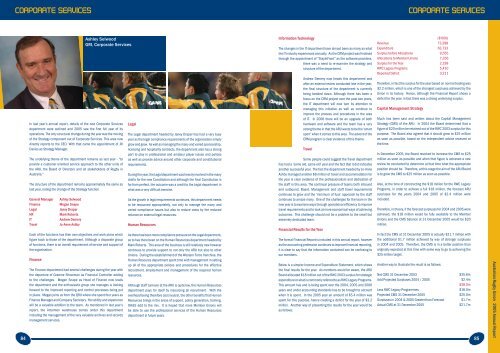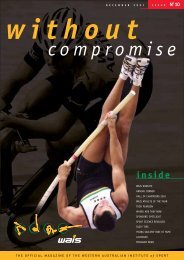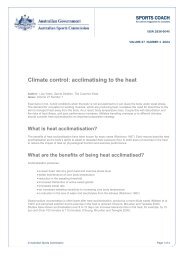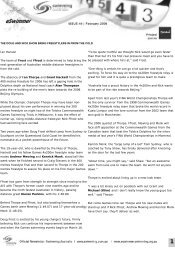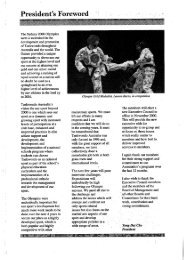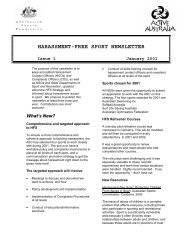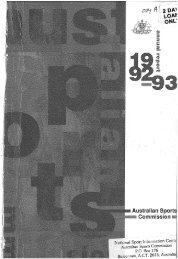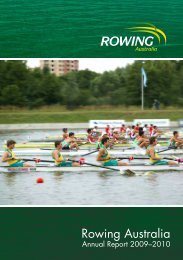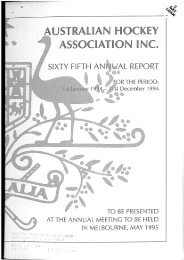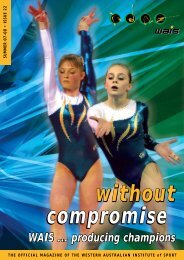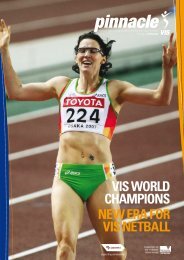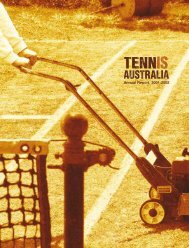community rugby - Australian Sports Commission
community rugby - Australian Sports Commission
community rugby - Australian Sports Commission
Create successful ePaper yourself
Turn your PDF publications into a flip-book with our unique Google optimized e-Paper software.
CORPORATE SERVICES<br />
CORPORATE SERVICES<br />
84<br />
In last year’s annual report, details of the new Corporate Services<br />
department were outlined and 2005 saw the first full year of its<br />
operations. The only structural change during the year was the moving<br />
of the Strategy component out of Corporate Services. This area now<br />
directly reports to the CEO. With that came the appointment of Jill<br />
Davies as Strategy Manager.<br />
The underlying theme of the department remains as last year - “to<br />
provide a customer oriented service approach to the other units of<br />
the ARU, the Board of Directors and all stakeholders of Rugby in<br />
Australia.”<br />
The structure of the department remains approximately the same as<br />
last year, noting the change of the Strategy function<br />
General Manager<br />
Finance<br />
Legal<br />
HR<br />
IT<br />
Travel<br />
Ashley Selwood<br />
Megan Snape<br />
Janey Draper<br />
Mark Roberts<br />
Andrew Demery<br />
Jo-Anne Ashby<br />
Each of the functions has their own objectives and work plans which<br />
figure back to those of the department. Although a disparate group<br />
of functions, there is an overall requirement of service and support of<br />
the organisation.<br />
Finance<br />
Ashley Selwood<br />
GM, Corporate Services<br />
The Finance department had several challenges during the year with<br />
the departure of Graeme Shearman as Financial Controller adding<br />
to the challenges. Megan Snape as Head of Finance now leads<br />
the department and the enthusiastic group she manages is looking<br />
forward to the improved reporting and control processes being put<br />
in place. Megan joins us from the QRU where she spent four years as<br />
Finance Manager and Company Secretary. Her ability and experience<br />
will be a valuable addition to the team. As mentioned in last year’s<br />
report, the Artarmon warehouse comes under this department<br />
including the management of the very valuable archives and records<br />
management services.<br />
Legal<br />
The Legal department headed by Janey Draper has had a very busy<br />
year as the legal compliance requirements of the organisation simply<br />
grow and grow. As well as managing the many and varied sponsorship,<br />
licensing and hospitality contracts, the department also has a strong<br />
part to play in professional and amateur player issues and polices<br />
as well as provide advice around other corporate and constitutional<br />
requirements.<br />
During the year, the Legal department was heavily involved in the many<br />
drafts for the new Constitution and although the final Constitution is<br />
far from perfect, the outcome was a credit to the Legal department in<br />
what was a very difficult exercise.<br />
As the growth in legal requirements continues, this department needs<br />
to be resourced appropriately, not only to manage the many and<br />
varied compliance issues but also to reduce costs by the reduced<br />
reliance on external legal resources.<br />
Human Resources<br />
As there has been more compliance pressure on the Legal department,<br />
so to has there been on the Human Resources department headed by<br />
Mark Roberts. This area of the business is still relatively new however<br />
continues to provide support to not only the ARU but also to other<br />
Unions. During the establishment of the Western Force franchise, the<br />
Human Resource department spent time with management in setting<br />
up all of the appropriate polices and procedures for the effective<br />
recruitment, employment and management of the required human<br />
resources.<br />
Although staff turnover at the ARU is quite low, the Human Resources<br />
department pays for itself by insourcing all recruitment. With the<br />
overhead being therefore cost neutral, the other benefits that Human<br />
Resources brings in the areas of support, policy generation, training,<br />
OH&S add to the mix. It is hoped that more Member Unions will<br />
be able to use the professional services of the Human Resources<br />
department in future years.<br />
Information Technology<br />
The changes in the IT department have almost been as many as what<br />
the IT industry experiences annually. As the CRM project was finalised<br />
through the appointment of “StayInFront” as the software providers,<br />
there was a need to re-examine the strategy and<br />
structure of the department.<br />
Andrew Demery now heads this department and<br />
after an external review conducted late in the year,<br />
the final structure of the department is currently<br />
being bedded down. Although there has been a<br />
focus on the CRM project over the past two years,<br />
the IT department will now turn its attention to<br />
managing this initiative as well as continue to<br />
improve the process and procedures in the area<br />
of IT. In 2006 there will be an upgrade of both<br />
hardware and software and the team has a very<br />
strong theme in that the ARU wants to be the ‘smart<br />
sport’ when it comes to this area. The advent of the<br />
CRM program is clear evidence of this theme.<br />
Travel<br />
Some people could suggest the Travel department<br />
has had a ‘same old, same old’ year and the fact that it did indicates<br />
another successful year. The fact the department headed by Jo-Anne<br />
Ashby managed another $6 million of travel and accommodation for<br />
the year is clear evidence of the professionalism and dedication of<br />
the staff in this area. The continual pressure of teams both inbound<br />
and outbound, Board, Management and staff travel requirements<br />
continues to grow and the ‘minimum of fuss’ approach by the staff<br />
continues to amaze many. One of the challenges for the team in the<br />
new year is to examine ways through operational efficiency to improve<br />
travel requirements and to look at more economical ways of achieving<br />
outcomes. This challenge should not be a problem to the small but<br />
extremely dedicated team.<br />
Financial Results for the Year<br />
The formal Financial Report is included in this annual report, however<br />
as the accounting profession continues to improve financial reporting,<br />
it is clear to say that the information contained can be confusing to<br />
our members.<br />
Below is a simpler Income and Expenditure Statement, which shows<br />
the final results for the year. As members would be aware, the ARU<br />
Board allocated $18 million out of the RWC 2003 surplus for strategic<br />
expenditure or what is commonly referred to as RWC Legacy Programs.<br />
This amount has and is being spent over the 2004, 2005 and 2006<br />
years and under accounting standards has to be brought to account<br />
when it is spent. In the 2005 year an amount of $5.4 million was<br />
spent for this purpose, hence creating a deficit for the year of $3.2<br />
million. Another way of presenting the results for the year would be<br />
as follows:<br />
($’000)<br />
Revenue 73,288<br />
Expenditure 63,733<br />
Surplus before Allocations 9,555<br />
Allocations to Member Unions 7,356<br />
Surplus for the Year 2,199<br />
RWC Legacy Programs 5,410<br />
Reported Deficit 3,211<br />
Therefore, in fact the surplus for the year based on normal trading was<br />
$2.2 million, which is one of the strongest surpluses achieved by the<br />
Union in its history. Hence, although the Financial Report shows a<br />
deficit for the year, in fact there was a strong underlying surplus.<br />
Capital Management Strategy<br />
Much has been said and written about the Capital Management<br />
Strategy (CMS) of the ARU. In 2004 the Board determined that a<br />
figure of $20 million be retained out of the RWC 2003 surplus for this<br />
purpose. The Board also agreed that it should grow to $25 million<br />
as soon as possible, based on the independent advice received at<br />
the time.<br />
In December 2005, the Board resolved to increase the CMS to $25<br />
million as soon as possible and when that figure is achieved a new<br />
review be conducted to determine at that time what the appropriate<br />
position should be. Therefore, at this stage the aim of the ARU Board<br />
is to grow the CMS to $25 million as soon as possible.<br />
Also, at the time of constructing the $18 million for the RWC Legacy<br />
Programs, in order to achieve a full $18 million, the forecast ARU<br />
surpluses for the years 2004 and 2005 of $2.4 million were<br />
included.<br />
Therefore, in theory, if the forecast surpluses for 2004 and 2005 were<br />
achieved, the $18 million would be fully available to the Member<br />
Unions and the CMS balance at 31 December 2005 would be $20<br />
million.<br />
In fact the CMS at 31 December 2005 is actually $21.7 million with<br />
the additional $1.7 million achieved by way of stronger surpluses<br />
in 2004 and 2005. Therefore, the CMS is in a better position than<br />
originally expected at this time with some way to go to achieving the<br />
$25 million target.<br />
Another way to illustrate the result is as follows:<br />
Net CMS 31 December 2003<br />
Add Projected Surpluses 2004 / 2005<br />
Less RWC Legacy Programmes<br />
Projected CMS 31 December 2005<br />
Surpluses in 2004 & 2005 Greater than Forecast<br />
Actual CMS at 31 December 2005<br />
$35.6m<br />
$2.4m<br />
$38.0m<br />
$18.0m<br />
$20.0m<br />
$1.7m<br />
$21.7m<br />
85<br />
<strong>Australian</strong> Rugby Union 2005 Annual Report


